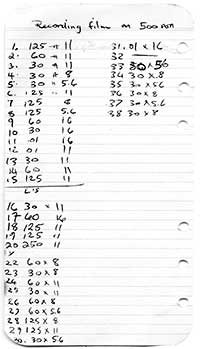.jpg)
Ten-After-Two
The setting
In 1979, I left the hustle and bustle of Vancouver’s Robson Street, moving across town to tony Kitsilano, a block away from the beach. My roommates and I occupied the top floor of a beautiful vintage house at 1st and Vine, long ago bulldozed and replaced by a nondescript condo. The rent was $190-a-month.
I had escaped the noise, cockroaches and midnight madmen (“Soothe them,” I implored the Fates), but not my own demons, as recorded in my journal — a litany of regrets, complaints that despite relative comforts, even a new girlfriend, “I’m bored bloody stiff,” and lamentations that “at my age,” 27, I should have achieved more.
These maudlin indulgences interrupt the record of mountaineering expeditions, wild trail rides in Stanley Park with colleagues from the Great Escape bicycle and outdoor store, weekend rock climbing forays, and obtaining my Canadian citizenship.
At the same time, photography made up no less of my feverish interests than did the study of climbing knots and “hex” placement — which I practiced on beach boulders (one of which was hauled up into the apartment to make the kitchen work-surface seen in the image below).
But I missed the Purcell Mountains, to which I returned whenever I could get a week or two off work.
After perhaps a ten-year hiatus, I returned to black and white film. This time I did so with intent, determined to explore the characteristics of different films.
.jpg)
Climbing Rack (stoppers. hexes, pitons, belay plate, and a couple of ice screws)
The film
I picked Kodak’s Recording Film 2475, as one of the first subjects of my research.
Recording Film was described as “An extremely high-speed panchromatic film with extended red sensitivity …. especially well-suited for applications requiring low-level illumination or short-duration exposures, such as law-enforcement photography,” with an exposure index of 1000. I chose to expose it at 500ASA and kept a record of the 38 exposures I squeezed out of the 36-exposure cassette, with my Russian Zenit-E camera (notice my journal, open on the desk, in top photo).
Development details are lost to time, but I recall having my friend Gerry Duncan at Action Reprographics — a specialty black & white lab, on 4th Avenue — put it through the soup.
As the accompanying images make clear, this film characteristically produced “golf-ball” grain, yet maintained surprising acutance.
All this seems amusing beside the latest high-ISO/low-noise digital sensors that can literally see in the dark (Canon’s latest entry in the low-light surveillance camera competition, the ME20F-SH, boasts an ISO equivalence of 4,000,000!)
But I wasn’t so much interested in using Recording Film to spy on my roommates as adding another “brush” to the photographic palette. As you can see, the pointillist effect works well for some subjects, not so well for others.
.jpg)
Go away, spy!
As it turned out, this Recording Film experiment was to be the first and last. I abandoned it for Kodak’s other low-light film, Royal-X Pan 120, with an exposure index of 1250. I developed this in Acufine developer, which enabled it to be pushed to 3,000 ASA. I still have a roll in the fridge, with an expiry date of 1986. Somewhere in my pack-rat nest, I believe I also have a can of powdered Acufine — perhaps the makings of another experiment.
The poem
On Kitsilano Beach
Last night I lay down in the sand
on Kitsilano Beach
looking up at the full moon
circled by a phosphorescent ring
The Big Dipper poured the darkness north
over Hollyburn Mountain, the Lions, and Garibaldi
I see cold light
etching the dark spire of Mount Waddington against the night
and the spine of Tiedemann running like some frozen monster in the eerie light.
Northward
the great St. Elias peaks rear from a gleaming tangle of glaciers:
Hubbard, Lowell, King George.
The mighty shoulders of Mount Logan reflecting the goddess herself
Moon and Mountain, two glorious beauties
mirror light over the barren red outcrops of the Ogilvies,
remains of ancient Yukon memory, at home at last on the weathered white domes
of the Richardson Range
And I am drawn by the lodestar
up and out of this circle of city lights
















Classic Film Review Blog – Kodak Recording Film 2475 – Alex Luyckx | Blog - […] Further Reading Don’t just take my word on Kodak 2475, you can check out the reviews by other awesome camera reviewers! Raymond Parker Photography – Remembering Recording Film 2475 […]March 6, 2025 – 3:01 am
Clark Castle - I only shot a couple of rolls of 2475. As you say grain like golf balls. i used one to shoot a Bill Evans concert and finished the roll with a Woody Herman concert. I would have to dig into my photo log to find what else I shot with it. My main concert film was Tri-X and then HP5.September 4, 2020 – 10:57 am
Raymond Parker - Recently, I’ve been scanning some HP5, pushed to 3200 and developed in Microphen. HP5 was my preferred concert and general low-light film until Delta 3200 came along. There’s some examples of both in my “Performers” gallery. I envy you seeing Woody Herman and Bill Evans. That must be a memory in itself.September 4, 2020 – 11:06 am